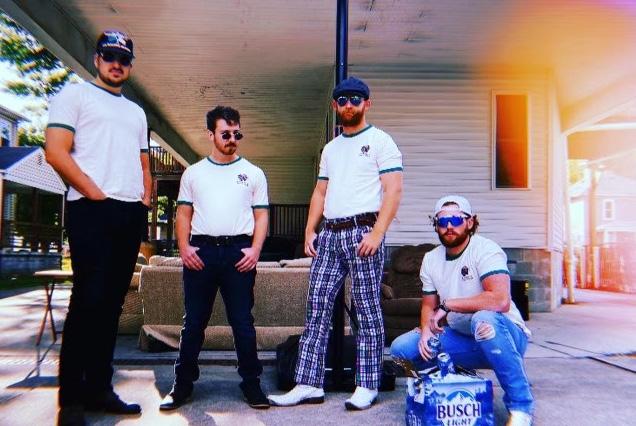
9 minute read
VOICES
from Vol. 14 Issue 4
VOICES A SURVIVOR’S STORY IN THE NEWSROOM
Backdrop Associate Editor Abby Neff shares her story of sexual harassment in campus media at OU and explores the consequences brought forth by the lack of women in journalism. STORY BY ABBY NEFF | ILLUSTRATIONS BY JULIA GREENWOOD
When I applied to Ohio University, I had to write a scholarship essay about my journalism experience. I focused on one article that I wrote with two other students about sexual assault and harassment at our high school. While I was reporting, I listened to teenage girls share their experiences with sexual harassment, sexual assault and rape. It was intense, but I never saw myself in any of their stories. I didn’t believe something like that could happen to me until last year when I was sexually harassed by an editor. I was working for a student publication at OU. I was a freshman.
Newsrooms are often overcrowded with male journalists. According to a survey published in 2018 by the News Leaders Association, women make up about 41.7 percent of newsroom employees overall.
The Women’s Media Center published a study in 2019 that examined the status of women in U.S. media. According to the WMC’s annual review, men still make up the majority of individuals in broadcast, print, internet and wire service outlets. Out of rank-and-file journalists, white women made up 30.4 percent of a newsroom. The issue is compounded when looking at race. According to WMC’s 2018 report on “The Status of Women of Color in U.S. Media,” also examining rank-and-file journalists, Black women only made up 2.78 %, Hispanic women were 2.71%, women of Asian descent were 2.63% and 0.04% were Hawaiian and Pacific Islander. Another survey by NLA in 2018 found that 0.25% of women in journalism overall were Native American, not including freelancers.
After I read about the sexual harassment lawsuits filed against a journalism professor at OU, I decided it was time to come forward with my own experience of sexual harassment — not just as a student journalist, but as a woman in a society that silences survivors.
The newsroom I was working in felt like a boy’s club. Most of my editors were male, and they were all friends. My relationship with one editor, in particular, started as a friendly and professional one. I was warned early in the semester that this editor had a history of making female staffers uncomfortable. The allegations included stories that he followed women home after parties and made possessive comments toward women who were in relationships with other people. Executive staff members told me I could come forward if he ever made me feel uncomfortable. I wanted to believe them. For a while I did, until it was clear I was on my own.
One night, I was at a party and he was there. We sparked friendly conversation while other people passed by us. “What if they think we’re together?” he says to me as I sit against a wall beside him, watching the drunken people in the room cluster onto a couch. “What?” I reply. Silence followed. A survey conducted by the Pew Research Center in 2018 found that 59% of women and 27% of men say they were sexually harassed at work or outside of work. Among the women who say they were sexually harassed, over half claim it happened to them both in and outside of work. What I found interesting from this study was that Americans tended to be more concerned about men getting away with sexual harassment and survivors not being believed than men being fired prematurely. The experience I had with editors in this student publication was the opposite of that sentiment.
I was promoted to a higher editing position and began working closely with this editor, even though I told him I didn’t want the position in the first place. I learned later he had the final say in hiring me. He was still my superior, as I was only an assistant editor. As a team, we worked well together. We shared editing styles, gathered staff writers to address grammar and clarifications for interviews — you know, journalism.
Our relationship changed pretty quickly. He started approaching me while I studied in the journalism building between classes. He would send me messages through Slack, a messaging app for professional organizations, teasing me both publicly and privately. He would try to
distract me while I was editing articles in the newsroom. Eventually, he started to silo me into a separate room with him, away from the rest of our staff. I felt uncomfortable. I stopped going to the journalism building in between classes to avoid him. One night in the newsroom, he asked me how I felt about him in a personal, non-professional way. My stomach dropped and my blood grew cold. I remember thinking, “Is this really happening?”
Finally, a colleague revealed to me that this editor had expressed a romantic and sexual interest in me and was sharing his feelings with the other executive staff members. No one was supposed to tell me. I resigned the next day.
A Nieman report published in 2014 found that since the 1980s, the number of female students enrolled in communication schools was equal to their male counterparts — and sometimes exceeded to the majority. The same number of women as men enter the industry right after graduation. And yet, women bow out of the field earlier than men. According to researchers, the biggest reason for the decline is a difference in lifestyle for both men and women, such as family obligations and schedule flexibility. As a result, there is a lack of women at the top in leadership roles. What happens if someone like my editor has a better chance of getting a leadership role in the industry than me?
When I resigned, I thought this editor might resign, too, or be removed. Executive staff members sent me texts and rang my phone off the line. One of them told me they had a bad feeling about the arrangement from the beginning. Another one told me I was going to be reprimanded for the professional issues associated with my decision, and that it was unfair I had requested this editor’s removal. I was overwhelmed with betrayal and anger, but most of all, I felt so alone.
His friends, my superiors, expressed their support for him. He was not removed. In fact, he was promoted to one of the highest leadership positions at the publication.
An executive staff member told me that no matter where I go and what newsroom I work in, there will always be a blend of personal and professional relationships. My relationship with this editor was neither personal nor professional. It was violating. I did not feel safe. My body did not feel safe. And I am not the only person who has felt that way because of a man. More importantly, I felt unsafe because of the system that allowed him to continue serving as an editor, despite his well-known history of predatory behavior.
For the past year, I have felt so ashamed. It felt as though the situation was my fault, and that if I had said less, done more and kept my head down, it wouldn’t have happened to me. I felt like I had a target on my back if I ever decided to speak out.
During that period of emotional isolation, I discovered bell hooks, a Black feminist author and social activist. A quote from her book, “The Will to Change: Men, Masculinity, and Love,” resonated with me. She says, “The first act of violence that patriarchy demands of males is not violence toward women. Instead, patriarchy demands of all males that they engage in acts of psychic self-mutilation, that they kill off the emotional parts of themselves. If an individual is not successful in emotionally crippling himself, he can count on patriarchal men to enact rituals of power that will assault his self-esteem.”
Sexual harassment does not exclusively start in professional industries. It starts on campuses, in classrooms, at bars, at work, on the street. In order to heal, we must acknowledge what is broken.
I don’t have any regrets, and I no longer feel guilty for sharing my story. Because it is just that: my story. Not his, not theirs, but mine. I am not a woman scorned. I’m on a path toward forgiveness, but not without seeking justice. b
The Survivor Advocacy Outreach Program can be reached at 740-591-4266. More information about SAOP can be found at https://www.saopseoh.org/. Any Ohio University student can reach OU’s Survivor Advocacy Program at 740-597-7233, and more information about the program can be found at https://www.ohio.edu/survivor.
Exhibit
BY DANTE CATANZARITE
A.
Dante Catanzarite is an Ohio University student studying integrated media. He’s also the creator of clothing brand Inferno & Co. Here’s some of his work, in his own words:
RIGHT
A Sailor and a Cowboy exchange tales of old while wearing The Nautical sweater and our fall Mr. Mojo Risin’ jacket. These two items were pivotal in expanding our product uniqueness and diversity. We are constantly adding new men’s —and soon to be women’s—items!
LEFT
This is my roommate Justin Carlson. While ordering samples of a women's romper for our summer collection, we accidentally received a men’s size! Capitalizing on this opportunity, we saw no better way to wear this romper other than having the Champagne of Beers (Miller High Life), while living the High Life. He looked so good, we’ve decided to release both a men’s and women's version of the romper this summer.


ABOVE
These shirts were a part of our first ever release. A little rough around the edges, but these boys emphasize their disregard for the opinions of others by their sheer ignorance. Some may call it trailblazing; some may be so bold as to call it pioneering.

ABOVE
The story of Inferno & Co. is of hard work, perseverance, vision, determination and sweat. But mostly, my sweat. I started the company amidst the pandemic with the central theme being clothing for “Grit n’ Grind.” Grit is a beautiful word, which simply means to have an unrelenting will to achieve one's goals. It not only fits my life philosophy, but furthermore Grit is ubiquitous and is not defined by race, color, creed, class or gender. Simply, my brand is merely a reflection of those striving to achieve the ultimate goal of “True Grit.”







